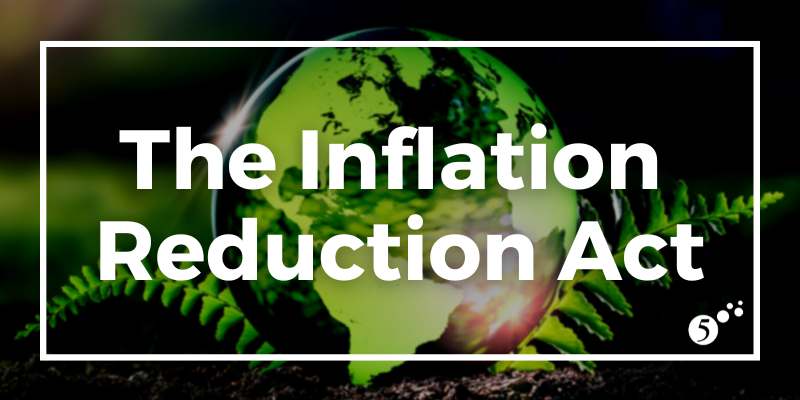2 min read
Lubbock: Deregulation 101
By 5 on November 17, 2022
Topics: Markets ERCOT Lubbock
10 min read
November 2022 - Energy Market Letter
By Jon Moore on November 2, 2022
On behalf of the team at 5, I am pleased to forward our November market letter. This letter discusses: (i) the upcoming Mid-Term Elections, and how the results could impact energy policy; and (ii) the challenges facing grid system operators in Texas, New England and New York as they work to integrate large volumes of intermittent resources into the grid mix.
The Mid-Term Elections
Recent polls favor Republicans to take control of the House and perhaps the Senate as well. As a result, several clients have asked what such a change in Washington could mean for energy policy. The question is particularly interesting because the landmark Inflation Reduction Act (IRA), which allocated some $369 billion to the energy sector, was passed by the Senate and the House without a single Republican vote.
The Inflation Reduction Act: The short answer is that the election results will probably have little effect on energy policy. While a change in control of the House or the shift of a single Senate seat would have doomed passage of this legislation, since it was passed and signed into law by President Biden, it will be difficult to repeal it. Even if the House and Senate pass legislation to repeal or amend portions of the IRA, President Biden has veto power, and overriding a veto requires a vote of two-thirds of the members in the House and Senate. This is good news for developers of renewable power, energy storage, electrical vehicle manufacturers and others that will benefit from the incentives found in the IRA. But this does not mean that the IRA and its various energy incentives are immune from challenges in the courts.
There are some interesting parallels between the IRA and the Affordable Care Act (ACA). Like the IRA, the Democrats used budget reconciliation to get the ACA approved by the Senate, and all Republicans in the House and Senate opposed the ACA. President Obama signed the ACA in March 2010, and in the November 2010 mid-term elections, the Democrats lost control of the House, in part, because of opposition to the ACA. The new congress did not reverse or upend the ACA, in part because politicians have little appetite for taking benefits away from voters. Yet the law became the subject of extensive legal challenges, one of which ended up in the Supreme Court.
While there is considerable opposition to the IRA, and it will undoubtedly face legal challenges, even though the law does not appear to be subject to the same serious constitutional challenges (for example, the constitutionality of the insurance mandate) that faced the ACA. In addition, as in the case of the ACA, we expect that in the two years remaining in the Biden Administration, a significant amount of the benefits will be granted to various energy projects. Once grants are made, it will be difficult if not impossible to reverse them.
Congressional Oversight: While the IRA may be safe from legal challenges, we expect that a Republican controlled house will use its oversight powers to review almost all aspects of the IRA and other programs that address climate change. This could certainly cause some delays in the implementation of the IRA’s programs and slow or halt other efforts to address climate change such as the SEC’s plan to require ESG reporting. For example, comments from Rep. Garland “Andy” Barr of Kentucky, a member of the House Financial Services Committee, indicated that ESG principles, “will be one of the major focuses of oversight of a Republican majority” adding that “My view is that ESG investing is a cancer within our capital markets,” Barr said. “It is a fraud on American investors.”
On the state level, we have already seen several states, pushing back against BlackRock and other investment firms that prioritize ESG principles. Texas has passed legislation that restricts the state’s retirement and investment funds from doing business with firms that “boycott” the oil and gas sector. Echoing this approach, Louisiana Treasurer John Schroder recently pulled $794 billion in pension fund money from BlackRock funds due to their use of ESG criteria in making investment decisions. “Your blatantly anti-fossil fuel policies would destroy Louisiana’s economy,” Schroder said. “In my opinion, your support of ESG investing is inconsistent with the best economic interests and values of Louisiana,” Schroder said.
Other than some minor changes to the approval process to FERC commissioners, we cannot think of other ways that a change in House or Senate leadership will impact federal energy policy – but as noted above, there is no shortage of ways in which the House and Senate can investigate the energy industry.
Looking past the mid-terms, if a Republican candidate is elected President in 2024, we might see an effort to pass legislation repealing the IRA. When President Donald Trump was elected in November 2016, Vice President Mike Pence stated, “President elect Donald Trump will prioritize repealing President Barack Obama’s landmark health care law right ‘out of the gate’ once he takes office.”
But as I expect will be the case with the IRA, once the energy community is offered the $369 billion in incentives, it will be very difficult for a future administration to repeal these benefits.
Permitting Reform: While repealing the IRA may be top of mind, the fate of Sen. Manchin’s effort to expedite permitting of critical energy infrastructure is equally important. In the run up to passage of the IRA, Senate Majority Leader Schumer agreed to support Manchin’s permitting bill (which included a requirement that Federal Agencies approve the controversial Mountain Valley Pipeline that Manchin supports) in exchange for Manchin’s support of the IRA. The bill seemed to be a good compromise, angering both Republicans who said it did not do enough for the fossil fuel industry and Democrats who said it did too much.
After the mid-term elections, it will be interesting to see if the Manchin bill can form the basis of bipartisan legislation that addresses the need to upgrade the nation’s energy infrastructure. As we note in the last section of this letter, there is a growing consensus among all participants that the grid envisioned by the energy transition does not yet exist. A recent Washington Post story is emblematic of the issue faced by new generation and transmission projects across the nation.
In this case, nearly ten years into the permitting process, a geo-thermal company had started construction of a plant that would provide carbon free energy to California residents. Late into this process, developers found out that: (i) the warm water drawn from the earth to power generation may threaten a rare toad, and (ii) the project’s location impinges on a sacred healing place for the Shoshone Tribe. The U.S. Fish and Wildlife Service has ordered the project stopped, while the Bureau of Land Management has pointed to the project as one of the ways the Biden administration is successfully confronting the climate crisis. This is just the kind of permitting delay that the Manchin bill was designed to address.
Intermittent Resources and The Energy Transition
Intermittent resources are generating assets that are not continuously available such as electricity that comes from wind farms and solar arrays. The growth of intermittent generation continues to challenge system operators who are responsible for ensuring a reliable supply of electricity. In the balance of this letter, we discuss ways in which intermittent supplies are challenging three markets, ERCOT, the New England ISO (NEISO) and New York ISO (NYISO).[1]
ERCOT: In ERCOT, the state in the country with the highest volume of wind and solar generation, we are clearly seeing the challenge that intermittent generation places on the system operators responsible for managing the reliability of the grid. As shown in Figure 1, on one day in Mid-October, wind resources generated approximately 18,000 MWs in the morning and only 1,200 MWs in the afternoon. The variation of solar output is equally dramatic. The chart below shows the combined hourly output of wind and solar over the last several weeks.
Topics: Markets Natural Gas NYISO ERCOT Sustainability Newsletters Education Renewables
3 min read
Big Risks this Winter
By 5 on September 29, 2022
Forward commodity markets were created to allow market participants to mitigate price risk for a given commodity. Long before the world ran on oil and natural gas, agricultural commodities traded in the forwards. By the 1860s, the Chicago Board of Trade was using standard instruments to trade wheat, corn, cattle, and pork. By the 1870s, the New York Mercantile Exchange was created by a group of Manhattan dairy merchants looking to standardize the chaotic butter and cheese markets. Over the next 100 years, these markets matured and expanded, but their purpose has remained the same: to create a marketplace that allows buyers and sellers to access a standard and liquid market that mitigates forward risk to commodity price volatility.
Topics: Markets NYISO
4 min read
When Crude Goes Down, Gas Goes Up
By 5 on September 29, 2022
Often in commodity trading, it isn’t always the straight-forward market drivers that catch the market off guard. Rather it’s the counter-intuitive things that seem to side-swipe a market. Lately, there has been a negative correlation between the price of crude oil and the price of natural gas. This summer, a decrease in the price of crude oil has coincided with a rally in natural gas prices. This month, the inverse relationship between these two commodities will be examined in more detail.
Topics: Markets Natural Gas
2 min read
5CP and Summer Recap
By 5 on September 29, 2022
Leaves are changing and temperatures are falling, which can only signify one thing: PJM’s coincidental peak season is behind us. In PJM, there are five Coincidental Peaks (5CP) that are determined by the five highest daily peak hourly loads for the summer. Once the 5CP season comes to an end, the utilities begin the process of calculating Peak Load Contributions (PLC) and capacity costs for the upcoming year. Typically, 5CP events occur in PJM when the hourly load forecast approaches 140,000 MWs. The summer of 2022 was no different.
Topics: Markets PJM
3 min read
Is Texas the New California?
By 5 on September 29, 2022
There is no doubt that the rapid growth of utility-scale solar in Texas has helped the state meet its ever-increasing electricity demand during hot and dry summer afternoons. The 10X increase in solar capacity in ERCOT over the past five years has kept summer afternoon peak prices in check, contributing to almost 6% of ERCOT’s total power this year (over 17 million MWh of emission-free power). But all that shimmers in the West Texas sun is not gold, and as California is learning, solar alone will not solve the state’s capacity problems.
Topics: Markets ERCOT
5 min read
The European Energy Crisis
By 5 on September 29, 2022
Imagine the reaction of a modest homeowner in America who received an invoice from their electric utility that was more than $1,000 per month, or a monthly natural gas bill that exceeded $500. While these figures may seem outrageous, this is the situation that many in Europe are facing as they head into the fall and winter heating season. Anyone who has shopped for natural gas or electricity knows that prices have consistently increased over the last 18 months. Many homes and businesses are seeing electricity and natural gas rates that are between three and five times higher than previous contracted rates. And while there is no question that this is painful, the situation in the United States is not nearly as desperate as it is in Europe. The chart in Figure 1 shows that the price of natural gas for January delivery at the Dutch TTF trading hub peaked in late August at over $100/MMBtu. Domestically, on August 23, that same contract hit its maximum value of $9.77/MMBtu, making the European price of natural gas ten times more expensive than in the United States for that October contract. Circumstances are similar in Europe’s electricity markets. In late August, wholesale electricity prices in France were more than five times the wholesale price of electricity in New York City. As Figure 1 shows, the price of that January contract has fallen in Europe (and domestically) over the last month, but it also illustrates the dramatic difference in energy prices on both sides of the Atlantic Ocean.
Topics: Markets Natural Gas
2 min read
A Not-So-Hot Summer
By 5 on August 31, 2022
As the calendar flips from August to September, ICAP management season is winding down, school is back in session and both the Mets and the Yankees are in first place. And while this summer was pretty hot for New York baseball, it was very ordinary in terms of the temperature. The months of July and August are particularly important for electricity customers in New York because a significant portion of next year’s electricity bill, the capacity obligation, is based on how much electricity a meter uses on the grid’s one highest hour of demand during those two months.
Topics: Markets NYISO
3 min read
A Fundamentally Different Market
By 5 on August 31, 2022
Earlier this year, we wrote an article describing the rapid acceleration of price volatility in the natural gas markets, with a chart that showed daily price movement at the Henry Hub, the national benchmark trading hub for natural gas. In this chart, shown in Figure 1, the y-axis is the daily price change in natural gas prices over the last ten years. A negative number means the price went down and a positive number means the prices increased during that day’s trading session. This chart shows that since the summer of 2021, there is a higher degree of scatter among the data points, indicating that gas prices have become increasingly volatile over the past 12 months. One interesting feature that this data shows is this volatility has not been predominantly in one direction, or skewed to either the upside or downside, rather, it has been evenly distributed around the mean.
Topics: Markets Natural Gas
4 min read
The Inflation Reduction Act
By 5 on August 31, 2022
The Inflation Reduction Act was signed into law this month. As a budget reconciliation law, it impacts federal income and spending. For 5 and our customers, this law provides increased incentives for on-site renewable projects that support the energy transition.








